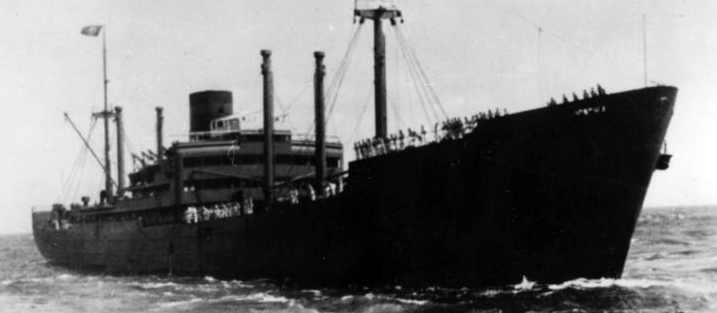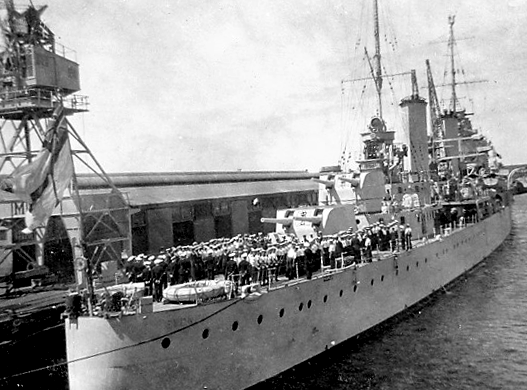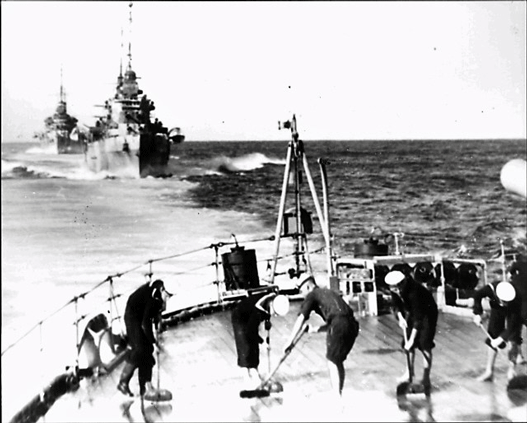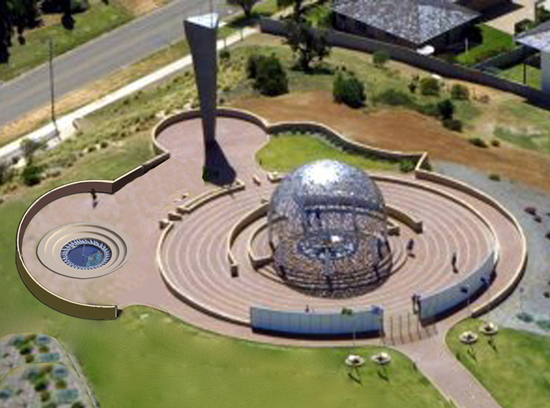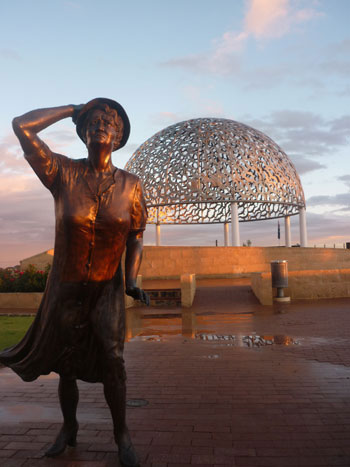HMAS Sydney II was Australia’s most famous warship after her success in the Mediterranean against Italian cruisers during the Battle of Cape Spada during those critical early days in World War II. The battle with HSK Kormoran which occurred off the Western Australian coast on the 19th November 1941 between this ship and the German raider HSK Kormoran, and the resulting destruction of both vessels, resulted in anguish and disbelief that is still evident in the Australian psyche, a defining event in Australia’s cultural history.
Source: Royal Australian Navy
Source: German Federal Archive
The tragic loss of HMAS Sydney II along with its entire crew of 645 was the first and most significant in a succession of Australian naval losses that directly threatened the security of Australia and the surrounding seas, having occurred only 17 days before the Japanese launched their attacks in Southeast Asia and the Northern Pacific.
For many decades the battle was shrouded in mystery. More than 80 German sailors were also killed in the battle, but there were survivors and their accounts were the only first-person evidence of what had happened. Then, 70 years later, in 2008, after decades of speculation and searching, the shipwrecks of HMAS Sydney II and HSK Kormoran were located 22 kilometres apart, 290 kilometres west south west of Carnarvon, off the coast of Western Australia in 2500 metres of water. The ‘Finding Sydney Foundation’ and the crew members of the Geosounder, together with the Royal Australian Navy, were instrumental in the very detailed and complex task which this has involved.
Sonar and photographic imagery of HMAS Sydney II has revealed a largely intact hull at a depth of approximately 2470 metres, sitting upright on the seabed adjacent to a field of debris measuring about 230 metres wide and containing several other large pieces. The same techniques revealed HSK Kormoran at a similar depth – 2560 metres -broken into four large structures, the largest of which is the forward half of the ship. Most of the major fittings and equipment of the vessel are either still attached or are located in the surrounding debris field. In the case of the HSK Kormoran it is known that the ship was deliberately scuttled by explosives, so the damage does not directly relate to the action.
Source: Museum of Western Australia
Source: Museum of Western Australia
These wrecks were a significant addition to the National Heritage List and were included on 14 March 2011.
Theories and historical facts could now be reinterpreted with the stark archaeological evidence on the ocean floor. This evidence was pivotal to the findings of the 2009 HMAS Sydney II Commission of Enquiry (the Cole Enquiry) by providing physical evidence that allowed some of the circumstances for the loss of an important RAN asset to be better understood. It also enabled the enquiry to understand how the unique features of the disguised commerce raider Kormoran enabled this ship to avoid identification as HMAS Sydney II approached it to point blank range.
The surprise achieved was a major contributing factor in the subsequent destruction of HMAS Sydney II.
Most importantly of all, the discovery of HMAS Sydney II and HSK Kormoran using intelligent reassessment of data to allow targeting of high-tech search equipment in the vast ocean reaches has highlighted the ongoing importance of finding reasons for the destruction of these vessels.
The location, interpretation and memorialisation of these shipwrecks have proved an ongoing importance for the wider Australian community, veterans, defence personnel, as well as closure for the grieving families.
An Account of the Battle between HMAS Sydney II and HSK Kormoran on 19th November 1941
This account is quoted from the following official history by G. Herman Gill, Royal Australian Navy 1939 -1942, Australia in the War of 1939 -1945, Series 2 (Navy), Vol.1 (Canberra: The Australian War Memorial, 1957): pages 450 -60.
“On the afternoon of 19 November 1941, the German auxiliary cruiser Kormoran (Commander Theodor Detmers) was steaming on a north-easterly course off the coast of Western Australia, approximately 150 miles south west of Carnarvon. Just before 4.00 pm a warship was sighted and Commander Detmers turned the Kormoran west into the sun, increasing speed to 16.5 knots, the maximum available. A broken piston rod was soon to reduce this to 14 knots.
The approaching warship, the light cruiser HMAS Sydney, had sighted the Kormoran and increased speed to intercept her. She quickly began to overhaul the raider, approaching on a slightly converging course off the German’s starboard quarter and flashing the signal NNJ (“You should make your signal letters”) on her searchlight. It was not Kormoran’s business to fight warships except as a last resort, as her best hope for survival was to convince the Sydney that she was an innocent merchantman. If fighting became unavoidable, however, the raider was best served by luring her opponent as close as possible before revealing her concealed armament. To this end, when replying to Sydney’s signal, the raider’s flag hoist was deliberately fumbled and then hoisted in a position where the flags would be obscured by the funnel and difficult to read. The Sydney repeatedly demanded that the signal be hoisted clear, and, when the Kormoran eventually complied, the letters PKQI could be discerned. This was the call sign of the Dutch freighter Straat Malakka.
While this was taking place the range was steadily closing. By 5.00 the Sydney was off the Kormoran’s port quarter and drawing abeam to a position where the raider’s armament could be used to maximum effect. Still hoping to pass as a Dutch ship Straat Malakka, the raider began to broadcast QQQQ (“suspicious ship sighted”). This message was received faintly, in garbled form, by the tug UCO and the wireless station at Geraldton, and, presumably, by the Sydney.
Sydney next signalled: “Where bound?”, to which the Kormoran replied: “Batavia”. Captain Burnett must have been still suspicious as the Australian cruiser’s next signal was “IX”. To the Germans this signal made no sense as, according to the code book, it meant “You should prepare for a cyclone, hurricane or typhoon”. The letters were in fact the middle letters of the secret call sign of the real Straat Malakka (IIXP) and the correct response was to send the outer letters. This, of course, the Kormoran could not do.
It was 5.30 and the ships were steaming parallel on south easterly courses at 14 knots, the Australian cruiser abeam of the raider at a range of 1500 metres, a perfect target. The Sydney’s fate was sealed when she flashed to the Kormoran: “Show your secret sign. “Detmers now had no choice but to fight. The Kormoran hoisted the German ensign, uncovered her armament and opened fire. Two ranging shots pitched short and over respectively then a full salvo hit, smashing into the Sydney’s bridge structure and director tower. Simultaneously, the Kormoran fired two torpedoes. Her automatic 2-centimetre anti-aircraft guns and rapid firing 3.7-centimetre anti-tank guns played onto the cruiser’s bridge and also amidships, where the two port four-inch guns of the secondary armament and the torpedo tubes were mounted.
The Sydney replied with a salvo from her six-inch guns that tore over the Kormoran. However, the cruiser’s forward turrets were knocked out by the raider’s third and fourth salvoes, then the fifth caught the Sydney’s aircraft on the catapult, wrecking it and spreading burning fuel over the ship amidships. About this time the Sydney’s after turrets came into action, firing in local control. Y turret fired two or three unsuccessful salvoes before falling silent but X turret opened a rapid and accurate fire which hit the Kormoran in the funnel, engine room and electrical installations, starting uncontrollable fires. Shortly after this, one of the raider’s torpedoes hit the Sydney abreast her forward turrets. Within five minutes of the commencement of the action both ships were mortally wounded.
The Sydney, down by the bow, turned sharply to port onto a southerly course as if to ram the Kormoran or to bring her starboard torpedo tubes to bear. She passed close astern, under fire from the raider’s after guns At 5.45 pm, as the range opened, the cruiser fired her four starboard torpedoes at the raider, all of which narrowly missed astern. About the same time the Kormoran’s engines broke down.
As the Sydney struggled off to the south she was hit repeatedly by the Kormoran’s port side guns and at 6.00 pm the raider fired a torpedo from her port underwater tube which missed. The Kormoran continued to fire at the Sydney until 6.25, by which time her own engine room was wrecked and uncontrollably ablaze. As a raider she was finished and, mindful of her full cargo of mines, Detmers ordered her abandoned. As the crew left the Kormoran scuttling charges were set. They were fired at midnight when the last of the crew had departed. At 12.30 the mines exploded and the Kormoran sank. Of her crew of 393 officers and men, 78 lost their lives, either in the action or the sea afterwards. Two captured Chinese were also killed. The Sydney was last seen about ten miles away, well ablaze and limping off into the gathering evening. Her glare could be distinguished until 10.00 pm and then only occasional flickering which had ceased by midnight”.
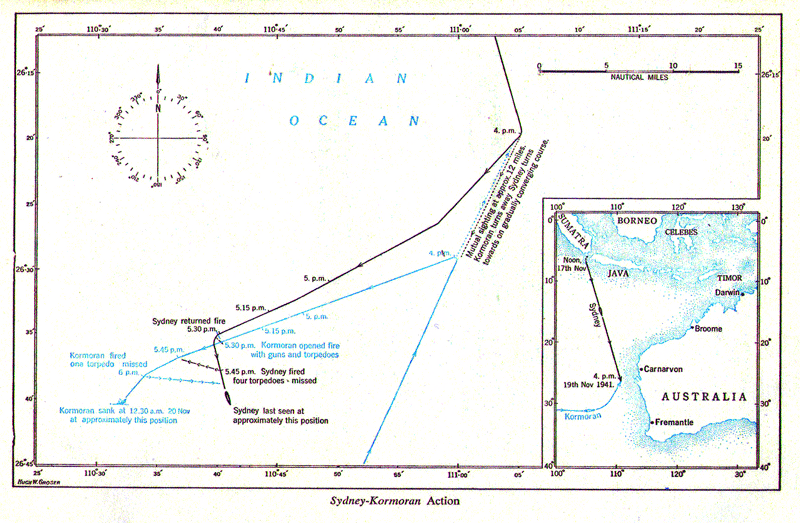
Source: Australian War Memorial by G. Hermonm Gill
Of HMAS Sydney’s total complement of 645 officer and men, none survived. The only material evidence known to have been recovered from Sydney at the time was an Australian naval-type Carley life raft recovered eight days after the action by HMAS Heros, and an Australian naval-pattern lifebelt recovered by HMAS Wyrallah. The Carley float is now preserved in the Australian War Memorial in Canberra.”
(Note that this précis of the battle was written prior to the discovery of the wrecks.)
The National Heritage Listing
The National Heritage List records the following significance reasons for listing the HMAS Sydney II and HSK Kormoran shipwrecks on the National Heritage List. They have outstanding heritage value to the nation because of their importance in a defining event in Australia’s cultural history and for their development in the process of the defence of Australia. These include:
- The tragic loss of HMAS Sydney II along with its entire crew of 645 following the battle remains as Australia’s worst naval disaster and sent shockwaves throughout the Australian community in November 1941.
- The HSK Kormoran also sank after the battle and more than 78 German sailors died.
- This battle brought the Second World War to Australia’s doorstep and highlighted its vulnerability to attack.
- The loss of HMAS Sydney II was the first and most significant in a succession of Australian naval losses that directly threatened the security of Australia and the surrounding seas, having occurred only 17 days before the Japanese launched their attacks in Southeast Asia and the Northern Pacific.
- The loss of HMAS Sydney II and several other Australian warships around this time contributed to a shift towards the idea of homeland defence rather than defence of the British Empire and resulted in the development of a defence alliance with the United States.
- The discovery and inspection of HMAS Sydney II and HSK Kormoran in 2008 has enabled reconciliation of theory and historical fact concerning the battle with the archaeological evidence present in the remains.
- During the relatively short but conspicuous career of HMAS Sydney II, it was commanded by two of the most highly regarded and respected officers serving in the Royal Australian Navy at that time in Captain J.A. Collins and Captain J. Burnett. Their association with HMAS Sydney II is significant in both their naval careers and of the ship itself.
- The sites have a special association with the Australian community particularly for family and friends of personnel who died in battle.
- The discovery of the wrecks in 2008 highlighted the ongoing importance of these shipwrecks and their stories to Australians.
Source: Royal Australian Navy
Source: Royal Australian Navy

Source: West Australian Museum
References
National Heritage :List, HMAS Sydney II and HSK Kormoran Shipwreck Sites, Carnarvon, EXT, Australia:
Museum WA, HMAS SYDNEY (II), 19 NOVEMBER 1941
Royal Australian Navy, History of HMAS Sydney Part 1
Royal Australian Navy, History of HMAS Sydney Part 2
Royal Australian Navy, History of HMAS Sydney Part 3
Royal Australian Navy, History of HMAS Sydney Part 4
Royal Australian Navy, Finding HMAS Sydney
Australian War Memorial, HMAS Sydney II and the Kormoran
Naval Association of Australia, HMAS Sydney II Virtual Memorial
Further Reading
Naval Historical Society, The Long Journey Home – Unknown HMAS Sydney Sailor
Naval Historical Society, The Sydney – Kormoran Engagement – Part 1
Naval Historical Society, The Sydney – Kormoran Engagement – Part 2
Source: HMAS Sydney II Memorial Geraldton

